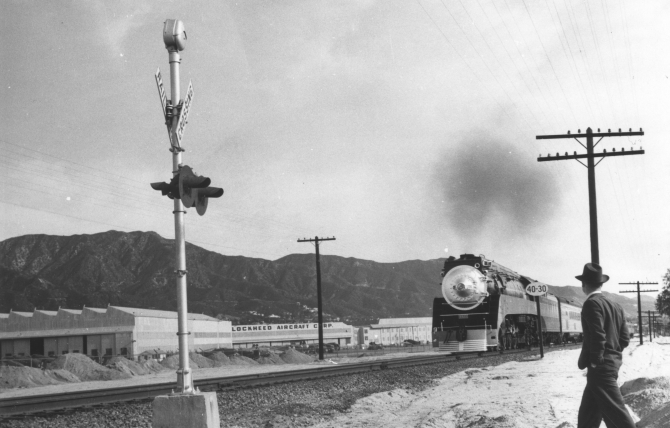During the waning weeks of 1940, war waged overseas and it was becoming apparent that the United States’ days of neutrality were numbered. Roosevelt’s Lend-Lease Act recently proposed and soon to be passed by Congress allowed the U.S. government to provide no-cost materials to foreign powers, which included airplanes. The country would be ready to deliver. The aerospace industry had been growing by leaps and bounds throughout the U.S. and had become so dominant that Fortune magazine devoted an entire issue to air-power. Greater Los Angeles had emerged as an aerospace giant, prompting Fortune to dedicate a segment of the air issue to the region. Needing images to accompany the article, they turned to Ansel Adams.
By this time Adams had made a name for himself with his creative work documenting natural landscapes, but was still forced to take commercial jobs to earn a living. Though residing in his native San Francisco at the time, Adams took Fortune up on their offer and made the journey south at the end of December 1940. His main focus during the assignment was two airplane manufacturing facilities; Douglas in Santa Monica and Lockheed in Burbank. For both locales, he documented the flurry of activity as legions of workers broke for lunch, but also captured some of the employees in nearby homes or bars and bowling alleys. He also journeyed throughout the city and beyond, capturing architecture and Angelenos from downtown to the ocean. Over the course of the assignment, Adams shot over 200 frames on 120 film which were sent to Fortune. The March 1941 issue included twelve of the photos in a piece called “City of Angeles.” Most of the negatives were returned to Adams who filed them away and quickly forgot about them.
In 1962, as Adams was preparing to move to Monterey, he came across the Fortune photos and did something unusual; he decided to get rid of them. He contacted the Los Angeles Public Library, offering up 217 negatives and 135 contact prints with “no strings attached.” Reportedly, the only other time Adams ever donated a set of images was when he turned over his photos of the Manzanar War Relocation Center to the Library of Congress, noting the collection to be “an important historical document.” Of the Fortune photos, he advised the library that, “none of the pictures were very good,” and gave permission to “dispose of them in the incinerator” if they had no value. The library graciously accepted the donation, appraising the complete collection at $150 for tax purposes.
Eighty years later, the collection serves as a fascinating look a city that is now barely recognizable, other than an occasional landmark. Adams’ Los Angeles is one on the eve of direct war and a massive population boom caused in part by the opportunities provided by aerospace. It’s a city of modest but now long-vanished amusements, trailer courts that have been replaced by multi-million dollar developments, and airplane factories that once upon a time enticed workers from around the country. The photos have become a document of a once towering industry of Southern California that has long been in decline.
The images also give a glimpse into Ansel Adams working process. Much of the photographer’s signature works were the result of manipulation in the darkroom, where contrast could be enhanced with striking results. The Fortune images are raw, most likely not developed by Adams himself, and never given the careful treatment allotted to his more well-known works (aside from one image of a cemetery statue which ran in Fortune that Adams retained and published in one of his last portfolios). The Fortune set reflects a photographer exploring different angles to get the perfect shot, not immune to the occasional double exposure, and reveals what subjects particularly interested him, such as residents at the Olympic Trailer Court or a newsstand vendor at Lockheed. The collection is a rare look through the lens of Ansel Adams as a commercial photographer.
In contrast to the striking landscapes which made Ansel Adams a legend, this exhibition gives us the chance to observe his portrayal of people in the built environment. People living, working, and enjoying their city.
People going about their daily lives in the looming shadow of war.
